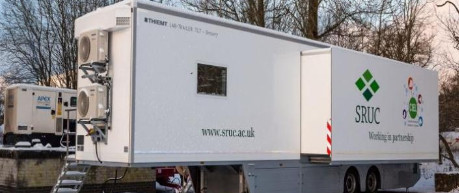Tuesday 20th March 2018, 9:00am
Consumers around the UK could soon be playing an important role in livestock genetics, thanks to a unique mobile sensory lab being unveiled this week by Scotland’s Rural College.

Members of the public will be invited into the lab – thought to be the first mobile unit of its kind – to taste different meats and other food products and indicate their preferences via electronic touch screens.
The lab will be equipped with state-of-the-art imaging technologies and meat quality equipment.
SRUC’s world-leading livestock scientists will use the information collected as part of their genetic improvement research which, in turn, will influence breeding programmes for sheep, cattle and pigs.
Supported and funded by the Centre of Innovation Excellence in Livestock (CIEL) and Innovate UK, the SRUC sensory lab is contained within an articulated lorry. It will soon be spotted outside supermarkets, at regional shows and in other public places around the UK as part of a three-year programme.
The mobile lab is the brainchild of Professor Mike Coffey, Team Leader for Animal and Veterinary Sciences at SRUC. It will be showcased this week at the Agricultural Engineering Precision Innovation Centre (Agri-EPI) Hub at Harper Adams University in Shropshire.
Hosted by the Knowledge Transfer Network (KTN) on behalf of Innovate UK, the event is a unique opportunity for the UK’s four Agri-Tech Centres: Agri-EPI, CIEL, Agrimetrics and the Centre for Crop Health and Protection (CHAP), to highlight their capabilities through bespoke ‘show and tell’ tours.
"Our overall aim is to improve the quality of the meat we consume. Instead of taking consumers into the lab, we will now be taking the lab out to consumers. Learning the taste preferences of the public – people of different ages, from different places and from different backgrounds – gives us valuable insight and will help us to improve the genetics of our farm animals. Thereby ensuring the consumer gets the products they want.”
"I’m pleased that CIEL funding has been able to bring this novel concept to reality. We believe innovations like this are vital for the UK agri-food sector to compete – in this case, making sure we are producing what the consumer wants. Breeding for specific traits like taste and tenderness of meat can takes years. Facilities like this will help determine breeding decisions and further improve the great products we produce in the UK."
Lyndsay Chapman, CEO, CIELSRUC will also be demonstrating how it uses various other state-of-the-art technology in its research, including 3D imaging for monitoring the growth and carcase characteristics of finishing beef cattle; collar-mounted individual animal sensors for monitoring feeding behaviour and intake of growing cattle; GPS collars using LoRaWAN – a Low Power Wide Area Network (LPWAN) – for monitoring the location of extensive livestock and new SRUC/Agri-Epi calf-rearing facilities.
Source: SRUC